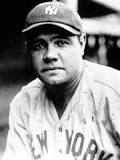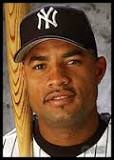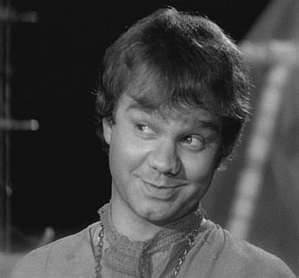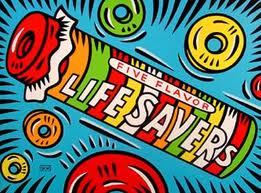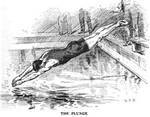The whole scene in this clip is so cool I can barely stand it. It’s a performance of “Sweet Georgia Brown” and “Tea for Two” by Anita O’Day at the Newport Jazz Festival in 1958.  It’s not only the singer and the songs I love, but the audience, too. The girl eating the hotdog, the one reading “Camille” in paperback, the young priest, all the people in the odd straw hats. Who are they and what became of them all in the last 55 years? The clip is from a documentary, a great one, called “Jazz on a Summer Day.” And if you want to know more about O’Day (and there is a LOT to know, including how out-of-her-mind stoned she was during this performance), you might like the DVD “Anita O’Day: The Life of a Jazz Singer.”
It’s not only the singer and the songs I love, but the audience, too. The girl eating the hotdog, the one reading “Camille” in paperback, the young priest, all the people in the odd straw hats. Who are they and what became of them all in the last 55 years? The clip is from a documentary, a great one, called “Jazz on a Summer Day.” And if you want to know more about O’Day (and there is a LOT to know, including how out-of-her-mind stoned she was during this performance), you might like the DVD “Anita O’Day: The Life of a Jazz Singer.”
Baseball: Salary Serenade
As Babe Ruth, the most glorious figure in baseball’s long history, readied himself for the 1930 season, he was approached by reporters who had learned the Babe’s new salary, $80,000, would be $5,000 more than President Herbert Hoover was earning. When questioned a little too closely on the subject, Ruth, then at the height of his powers, grew impatient. “What the hell has Hoover got to do with what I make?” he supposedly snapped. “Besides, I had a better year than he did.”
True or not, it’s a good story. At the time, especially after the economic collapse into what would become the Great Depression, it seemed impossible that a mere ballplayer could earn more than the president. Still, an exception could be, and was, made for Ruth, the great fan favorite whose prodigious slugging and outsized personality had helped lift the game from the dark days of the 1919 Black Sox scandal to unprecedented levels of popularity a decade later.
And, indeed, Ruth was the exception. For the game’s first 100 years, beginning in 1876, players’ salaries seemed generally to be in line with the work they did. They made more than the average Joe, but often had to supplement their earnings with off-season jobs at car dealerships, beer distributorships and the like. My favorite player, Jimmy Piersall, was an off-season ambassador for Cain’s mayonnaise, making appearances at grocery stores to sign autographs for kids and convince their moms to break the Hellman’s habit. Just before free agency was legalized in December 1975, the average player salary was $44,676. At that point, ballplayers still walked among us, blessed with great talent, to be sure, but not yet separated from us by moats of wealth and privilege.
Then came free agency. It was a much needed corrective at first, giving players freedoms long denied them to move among teams and negotiate terms. But that brief period of sunlight and equity has since turned into an ugly, out-of-control greedfest in which players and their canny agents have picked the owners’ pockets as if they were a bunch of hayseeds in an old vaudeville sketch—while the owners, in turn, have done the same dirty to fans with ever-escalating ticket prices and other costs at the ballpark. Now, any major leaguer who earns less than the President of the United States is barely a ballplayer at all—a reclamation project, a late-season call-up from the minors—and probably a source of economic embarrassment and pity among his teammates. The President’s salary at present is $400,000 a year; the minimum major-league salary is slightly higher than that, around $410,000, and the average is now $3.24 million a year.
Nothing will ever get that pig back into the sty. Even so, it remains possible to forget about player salaries momentarily when the action on the field gets exciting during a close game or a gripping stretch of the season. But then some multimillionaire doesn’t run out a grounder, or refuses to sign an autograph, or gets stopped at 2 a.m. for driving his Escalade at 97 mph down a city block, and it comes rushing back to me—that inglorious moment when I realized I’d no longer be able to stomach major league baseball’s absurd salary structure, and when I knew the game had left me for good.
No, it wasn’t Alex Rodriguez’s $252 million contract with the Rangers or his $275 million deal with the Yankees.
It wasn’t Barry Zito signing for seven years and $126 million with the Giants (Zito’s post-contract record at this point: 31-43).
It wasn’t Jason Bay joining the Mets for $16 million a year for six years coming off a season in which he batted .267.
It wasn’t chronic malingerer Carl Pavano (Carl Pavano!) getting $7 million a year from the Twins after posting a 5.10 ERA the previous year.
It wasn’t the unknown Russ Gload (a first baseman with 28 homers in 8 seasons) signing for $1.3 million, or former headcase Rick Ankiel being paid $3.25 million after a .230-11-38 season, or journeyman Randy Wolf at $10 million, or sub-.500 pitcher Brandon Lyon at $5 million.
No, my limit had already been reached several years earlier. That’s when lackluster utility outfielder (career average: .214-14-42) Ruben Rivera was voted off the Yankees by his teammates after it was discovered he had gone into Derek Jeter’s locker, stolen his glove and bat and sold them to a memorabilia collector for $2,500. The detail I almost didn’t notice at the time was that Rivera’s salary with the Yankees for that season was $1 million. One million dollars. Taking inflation into account, Babe Ruth’s 1930 salary of $80,000 with those same Yankees would have come to $860,000 in 2002—considerably less than that of even the lowly thief Rivera.
Knowing that one incredible fact—that baseball had regressed to the point where Ruben Rivera was more amply rewarded for his part in the game than the great Babe Ruth had been for his—who would ever again pay to see a game? Who could ever again raise a truly heartfelt cheer for the Yankees, or any other team for that matter? No, when it comes to salaries, baseball’s disgrace is not even open to debate.
Favorite Things: “Song Cycle” by Van Dyke Parks
I was 18 when I first heard “Song Cycle” by Van Dyke Parks and I haven’t been able to get it completely out of my head ever since. Its music was lush, swirling, convoluted, by turns lyrical and difficult. Its words were pretty much impenetrable. It was easy to dislike – and yet 45 years later, here I am, still listening to it. In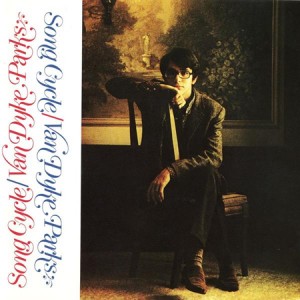 a way, I guess it has haunted me, like the wind blowing through the trees in “Blow Up” or the sound of my mother’s voice calling me and my siblings home for supper.
a way, I guess it has haunted me, like the wind blowing through the trees in “Blow Up” or the sound of my mother’s voice calling me and my siblings home for supper.
The amazing thing to me is that Parks was only 24 when he made “Song Cycle.” He seems to have been from some sort of show biz family. Strangely enough, he played Tommy Manacotti, the kid from upstairs in “The Honeymooners.” His brother, Carson, wrote “Somethin’ Stupid” for Nancy Sinatra and her dad.
But “Song Cycle” was a real departure. It was full of confidence and nerve and the audacity of youth. It tried dozens of different things, everything, it seemed, that Parks could think of – some were wildly successful, some just went thump, thump, thump. But the overall result, to me, was breathtaking. Or, as the review by Jim Miller in “Rolling Stone” said at the time, “The album is hardly perfect, but familiarity breeds awe at what, for a first album, has been accomplished. “Song Cycle” presents us with the work of a creative genius.” “Palm Desert” from “Song Cycle”
I see that Parks has a new album out. I haven’t listened to it yet, but I’m hoping for some kind of bookend to his effort of so long ago. In the meantime, I urge you to give “Song Cycle” a listen, if you can. You probably won’t like it, but on the other hand you might get lucky like I did and love it for the rest of your life.
Separated at Birth: Traitors to the Cause
Baseball: The Long and Long of It
On Sept. 28, 1919, the New York Giants beat the Philadelphia Phillies 6-1 in a nine-inning game that lasted 51 minutes. Granted, the game came on the last day of the season—the first half of a double-header that must have been like torture for the players. At the end of the day, the Phillies would sit a distant 47.5 games behind the pennant-winning Cincinnati Reds, while the Giants would end up 9 games back. Clearly, the players in Philadelphia that day were in a hurry to shut things down and get back home for some off-season hunting, fishing and drinking beer out of a pail. But still . . . 51 minutes.
 In recent years, there have been renditions of the pre-game National Anthem that have lasted 51 minutes. There have been relief pitchers who have taken 51 minutes to wander in from the bullpen. Robinson Cano takes that long to exit the batter’s box after hitting a home run (or even what he thinks might be a home run).
In recent years, there have been renditions of the pre-game National Anthem that have lasted 51 minutes. There have been relief pitchers who have taken 51 minutes to wander in from the bullpen. Robinson Cano takes that long to exit the batter’s box after hitting a home run (or even what he thinks might be a home run).
Which is to say the game has slowed down considerably since 1919. A typical American League game has grown from around an hour-and-a-half in the 1920s, to 1 hour and 58 minutes in 1943, to a stultifying 2 hours and 52 minutes in 2011. (with the Yankees at 3:08 per game, Red Sox at 3:04 and Dodgers at 3:02 taking top honors.) And that’s just the regular season. As we all know, it’s now, in October, when baseball truly wobbles off into deep space, sending fans both at home and at the ballpark into a post-season zombie state with gaping mouths, vacant eyes, twitching hands and feet, and, in many cases, a hunger for . . . football.
In the 2009 World Series between the Yankees and the Phillies, the games ran 3:27, 3:25, 3:25, 3:25, 3:26 and 3:52. The games in last year’s Series between the Cardinals and the Rangers ran well above three hours on average as well. Yesterday, the first two games of the 2012 post-season both checked in at over three hours, and I found myself awake at midnight, nodding off occasionally as I made sure the Orioles put the Rangers safely to bed for the winter. As a comparison, the 1957 World Series between the Yankees and Milwaukee Braves (a year I pulled at random) featured games, all daytime affairs, that ran 2:10, 2:26, 3:18, 2:31, 2:00, 2:09 and 2:34.
Baseball claims to be aware of the problem of excessively long games. Commissioner Selig periodically calls for measures to shorten the game. He does this in the same way that American presidents periodically call for measures to reduce the national debt. Analysis shows that the initiation of MLB’s new “speed-up” rules in 2008 dropped regular-season game times from 2:51 all the way down to 2:49. Selig vowed to impose the same rules as the 2010 season began, yet the first two games of the year between the Red Sox and Yankees lasted nearly 4 hours each and even brought a rebuke from umpire Joe West, who called the delay tactics employed by both teams “pathetic and embarrassing and a disgrace to baseball.” West, in turn, was criticized by Yankee Mariano Rivera and Boston’s Dustin Pedroia for daring to speak up, and reportedly admonished by MLB higher-ups. (It should be noted that no fans appear to have been consulted on the matter.) Anyway, even if Selig puts in serious measures to move things along, no one knows what might happen if teams fail to comply. My guess is that noncompliance would result in a long delay in the middle of the game as managers and umpires discussed just who was delaying the game, and how, and possibly even why.
You do have to wonder about a sport that, in an age when everything is delivered more quickly and efficiently, allows its product to drag on like a chess match in which the moves are sent back and forth by registered letter. It’s as if NASCAR suddenly decided to introduce the Daytona 5000. Or Uncle Ben’s came out with a new product: Hour Rice. You’re headed down the wrong road, baseball, and at this rate you’ll never find your way home again.
Which Actors Were in the Best Movies?
There are many subsets in the world of movies. Best Performance by a Chimpanzee is one (the immortal Cheetah, in “Tarzan and His Mate,” is the clear winner there). Worst Performance by Someone Trying to Throw a Baseball is another. The 10 Lamest Depictions of Jesus. Five Most Disruptive Examples of Speeding Up the Film. You get the idea.
One subset I got to thinking about the other day (a rainy one) is which actors had the good fortune to appear in the best movies. I mean, if you take the best five movies an actor ever performed in, how do those five stack up against everyone else’s top five? I did a little research and came up with the following ranking of my own top group – with a surprising winner (whose acting I don’t even really like very much). Maybe you can think of someone whose top five should be on the list, too. Maybe you can suggest two to fill out my Top 10. Remember, it’s not necessarily a recognition of superior acting, it’s all about the quality of the movies they were in. (And I will have to do actresses next.)
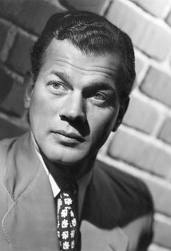 1. Joseph Cotten: Citizen Kane, Gaslight, Shadow of a Doubt, The Magnificent Ambersons, The Third Man.
1. Joseph Cotten: Citizen Kane, Gaslight, Shadow of a Doubt, The Magnificent Ambersons, The Third Man.
2. Jimmy Stewart: It’s a Wonderful Life, Vertigo, The Philadelphia Story, The Shop Around the Corner, Anatomy of a Murder.
3. Cary Grant: Notorious, His Girl Friday, The Philadelphia Story, North by Northwest, Bringing Up Baby.
4. Robert Duvall: The Godfather (I and II), Apocalypse Now, MASH, To Kill a Mockingbird, Lonesome Dove (TV).
5. Dustin Hoffman: The Graduate, Midnight Cowboy, Tootsie, All the President’s Men, Kramer Vs. Kramer.
6. Henry Fonda: Grapes of Wrath, The Lady Eve, My Darling Clementine, 12 Angry Men, Fort Apache.
7. Jack Nicholson: Chinatown, One Flew Over the Cuckoo’s Nest, The Shining, Reds, 5 Easy Pieces.
8. Claude Rains: The Invisible Man, Now, Voyager, Casablanca, The Adventures of Robin Hood, Notorious.
The Perfect Little Package
When we make consumer choices based on packaging, it’s usually a subconscious or barely conscious decision. For instance, when I choose Coke over Pepsi, it has nothing to do with the taste of the product (I preferred Pepsi in a blind taste test I took years ago) but rather the Coke can’s red color and logo have for so long subliminally symbolized “refreshment” to me that my eye and hand automatically seek it out. Similarly, when you choose Tide over All, or Aunt Jemima over Mrs. Butterworth, or Nestle’s Crunch over Hershey’s Crackle, or when you grab L’Eggs or Kleenex cubes, is it a matter of real superiority, or has the packaging somehow won you over?
Some products have packaging that more directly calls out to us. When Life Savers were introduced 100 years ago, their neat rolls of hole-in-the-middle candies were an instant fit for everyone’s pocket or handbag.
Similarly, Pringles were all about packaging, and distancing themselves from messy, greasy bags of chips that could break into pieces and quickly get stale.
And I have a hard time not buying The Farmer’s Cow milk. The cow on the carton recruits milk purchasers just as surely as Uncle Sam once recruited young men and women for service in the armed forces.
(And let’s not forget those special products that are ONLY about packaging. Would anyone buy PEZ candies if they didn’t come in their own dispensers?)
All of which brings me to the latest packaging marvel to enter my life: Talenti gelato. After a fair amount of testing (Tahitian Vanilla Bean, Belgian Milk Chocolate, Black Cherry Amarena, etc.), I can say that Talenti is a superior product, one I would buy for that reason alone despite its stiff price. But Talenti comes in sturdy plastic screw-top containers! 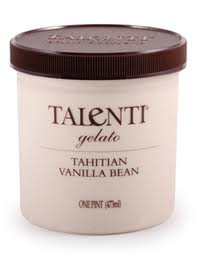
What a shapely, elegant little package! For me, it was love at first screw. The revolutionary lid maintains freshness in a way cardboard tops can’t. When you’re done (it won’t take long) you can recycle or reuse. (I’m sure “Hints from Heloise” could come up with dozens, if not hundreds, of uses for the empty container.) I’ve always felt that you must take beauty where you find it. For me, most recently, it was in the freezer aisle at my local Stop & Shop.
Tug of My Heart
As the madness in London is about to begin, the thing I want to know is why the tug-of-war is no longer an Olympic sport. That’s right – eight men or women at the end of a sturdy piece of rope, pulling with all their might for king and country.
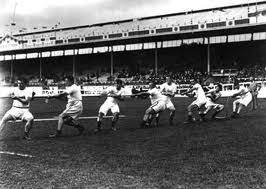 The tug-of-war actually was an Olympic sport beginning in 1900 and ending in 1920. No one seems to know why it was discontinued. It is inconceivable to me that golf and ice dancing and that gymnastics thing with the hoops and ribbons are all Olympic sports while the elemental battle of the tug-of-war can find no love at all.
The tug-of-war actually was an Olympic sport beginning in 1900 and ending in 1920. No one seems to know why it was discontinued. It is inconceivable to me that golf and ice dancing and that gymnastics thing with the hoops and ribbons are all Olympic sports while the elemental battle of the tug-of-war can find no love at all.
Can you imagine if we’d had the tug-of-war all along, in every Olympics year? England vs. Germany in 1936? U.S.A. vs. U.S.S.R. in 1960? (Would you care to cast in your head a Dirty Dozen-type movie about that one?) Israel vs. Egypt in 1968? The TV ratings would be off the charts. And can you imagine what the East German women’s tug-of-war team would have looked like? Epic.
Today’s match-up wouldn’t be bad either. North Korea vs. South Korea would be a highly entertaining spectacle, as would Australia vs. New Zealand or, I don’t know, ANY MATCH AT ALL!!
I suppose it’s too much to hope for a return in my lifetime, but you know what? I’m pulling for it.
Taking the Plunge
My father was born in 1911 and was a high school and college swimmer from 1925 to 1933 (Dartmouth record holder in the 150-yard backstroke, as he liked to point out), so it is natural that he was well versed in all the competitions—even the odd and obscure ones—having to do with his sport. Of these, one of his favorites was the Plunge. I fondly remember him demonstrating it to my brother Michael and me when we were boys, and then encouraging us to try it.
The Plunge was a simple event. You dove from the side of the pool and then tried to see how far you could float, without moving arms or legs, in 60 seconds. As I recall, the first part of the event was fun but the last 20 or so seconds were incredibly uneventful as, with your forward propulsion depleted, you basically floated in place until time was up (or you ran out of breath).
It wasn’t until years later that I discovered the Plunge had been a very popular event in the late 1800s and early 1900s, and indeed had been an Olympic event in the London Games of 1904. It cannot have been much of a spectator sport. Because competitors tended to drift sideways as well as forward (and perhaps even backward), they dove into the pool one by one rather than as a group. According to accounts of the day, the fatter you were, the better the chance you had of winning. It’s hard to imagine the Plunge in the age of the Speedo.
In any case, it’s one of the those rare Olympic events that you can picture yourself doing fairly well in. For reference, William Dickey of the New York Athletic Club was the gold medal winner in London (there were only five competitors), floating 62 feet six inches in the allotted time. It’s an Olympic record that stands to this day because the event was never a part of subsequent Olympiads. The world record of 80 feet was set in 1912 by University of Pennsylvania plunger S.B. Willis.
The NCAA dropped the Plunge as a college event in 1925, but maybe it’s time to bring it back. There’s a peaceful manatee-like quality to the Plunge, and none of the thrashing through the water that’s associated with other swimming events. In fact, it’s one of the few sports that allows you to compete and bask at the same time. You might give it a try yourself the next time you’re at the pool.
A Year in Nature: June 3
After seven straight days of rain the weather finally cleared today and I went out into the woods. The ground was very damp, a good time to look under logs. I love to roll the logs over in late spring and watch the bugs skitter for cover. Today, though, when I rolled one log I noticed that several particularly ugly and disgusting little beetles didn’t move. I looked at them more closely and soon realized that what I had before me were either long-dead trilobites or English hard candies. In the spirit of science, I picked one up, bit through the brittle shell, chewed into the spurting soft center and swallowed, The taste? The taste was not merely stale, but millions of years old, the taste of time passing, of ennui itself, yet not without a wicked hint of mothballs. Question: What were English hard candies doing under a log in the woods near my house?

